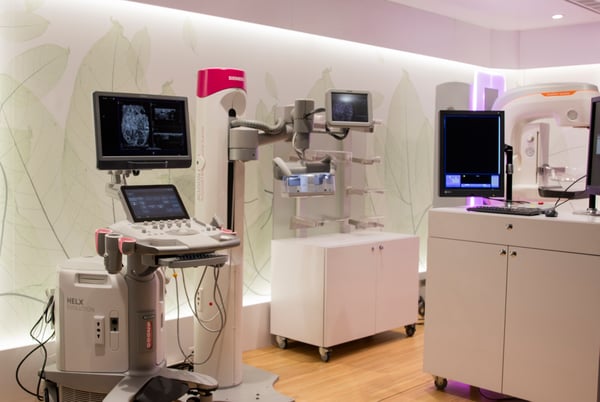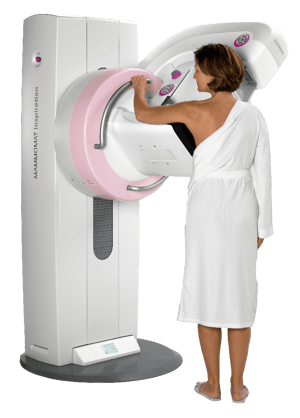
You know breast cancer screenings are important. The general public knows breast cancer screenings are important. Your own patients know breast cancer screenings are important.
So why don’t you have more patients coming in for their regularly scheduled preventive mammograms?
It’s a struggle many clinics and hospitals are familiar with. Most places understand intuitively that they have the patient population necessary to support a steady stream of mammograms. But translating that patient population into volume can sometimes be more difficult than it would initially seem.
This is an issue we’ve helped a number of facilities address, so I wanted to take a closer look at some of the solutions we’ve found that work well for increasing mammogram volume. By following these six steps (and, more importantly, sticking with them), you’ll be able to experience higher mammogram traffic at your organization.
Marketing, Marketing, Marketing
The first step is the most important: marketing your women’s health services.
You need to be talking about mammograms constantly. A patient shouldn’t be able to walk down the street without being reminded about the need for their annual or biannual mammogram. They shouldn’t be able to turn on the radio without hearing about breast health. They shouldn’t be able to go to their fridge for a snack without being reminded about the need to schedule an appointment (you sent your patients a branded refrigerator magnet, right?)
Marketing women’s health is the single most important thing you can do to increase breast volume. And here’s the thing: including women’s health in among a listing of your various radiology services doesn’t really cut it. When the average patient sees an ad for “Johnsonburg Hospital Radiology,” they don’t have the clinical wherewithal to connect that promotion to scheduling their mammogram.
Instead, you need to develop mammography-specific marketing materials across all the channels you would normally use to raise awareness about your organization. You ought to be marketing your mammogram service in the local paper, on radio stations, on the web, on social media and more.
We’ve found many providers have a lot of success with direct mail pieces. By sending mammogram screening postcards, booklets or other materials to your patient population, you create a reminder right within their home that they need to be proactive about their breast health. That’s why, as I noted above, a magnet can be so useful. Once the patient receives it, the vast majority of the time, they’re placing that magnet on their fridge where it will serve as a reminder to contact their doctor every year.
I understand: budgets are strained, as are time and resources. But even a little bit of awareness goes a long way toward developing a consistent stream of patients who seek you out for their preventive mammogram.
Provider Visibility
Of course, patients are only part of the equation. At the same time you encourage your patient base to ask their doctors for a referral, you also need to appeal to your referring providers to send their patients to you rather than the competition.
This is a very different kind of marketing. Patient-centric marketing is based on establishing awareness within your given geographic vicinity. Provider-centric marketing has to be a lot more laser-focused.
If you’re part of a large organization where the vast majority of referrals come internally via your staff physicians, think of marketing as relationship building, which still needs to be done consistently. If you rely on outside providers for your exam referrals, marketing for awareness is equally as important as relationship building.
Start by making a list of your referring providers. This shouldn’t take long. You probably have a pretty good idea of who the majority of your referring providers are (and if you don’t yet know that information, start by asking your patients at the time of service how they heard about you and keep track of that over time). I just want you to externalize the information you have maybe kept in your head.
With that list complete, make a list of providers you haven’t received referrals from. This is a little trickier, but the good folks at Google have made it a fairly straight-forward process. Draw a circle around your facility and look up all the physicians in that circle who could conceivably refer to you. You also should connect with other departments like oncology, obstetrics and internal medicine to get their referral lists.
Now you have your master list. At this point, you can start to market to these providers through any means necessary. Direct mail. Email. Targeted social media. Pick up the phone and call them. Whatever you can do to land on their radar, do it!
One thing that works really well is developing a marketing piece, for example, a poster, patient brochure or even a Referral Pad, and actually taking time to travel around to each of these facilities to drop it off. This works especially well if you have a new piece of technology to promote (physicians love shiny new things as much as anyone else does). Doing so gives you face time with the facility and lets you have your educational materials readily available for patients and staff to see for a long time to come.
 Tech the Next Step
Tech the Next Step
We mentioned a moment ago that marketing to providers works really well if you have a brand-new system to promote, and that advice goes for patients as well.
The features available on newer mammography systems really are remarkable. If a patient has put off their mammogram for a few years, they’ll likely be shocked to see some of the developments that have been made in a relatively short time span.
3D mammography can take clinical capabilities to the next level and aid the physician in their diagnosis in a way that isn’t possible with traditional 2D mammography. If you have a new system to promote, then lead with its benefits in your marketing!
This goes for physicians, too, although how you address them will be slightly different. While your patients are likely most concerned about early detection, it’s things like ease of diagnosis and high-quality images that will woo physicians.
A great way to land on the radar of referring physicians is to host an open house. Invite the provider community to actually see the technology in person, letting them judge for themselves the quality of the images in comparison with your old system or the competition. Have swag available for them to take so you remain in their memory for a long time to come.
By doing so, you’ll greatly increase your chances of new referrals.
Addressing Pain Points…Literally
I want to provide one quick warning when it comes to talking about features that improve patient comfort.
One of the reasons patients put off mammograms is concerns about pain. Maybe the person had a bad experience once or they’ve never actually had a mammogram. Still others put it off because they’re worried about what the screening is going to find.
The temptation is to address pain when raising awareness. But this can actually backfire. When you talk about features that reduce patient pain, that can give some patients the thought that there must, indeed, be some pain. Think of it this way: you don’t see many ads for dentist’s offices that say their facility provides less torture than the standard exam. That’s because less pain still means some pain.
So I would caution you not to zero in on reduced pain or the features that lead to reduced pain during a mammogram. Prevention, long-term health and patient experience are far better topics to focus on (patient experience is generic enough that you can promote it without getting into the nitty-gritty of pain reduction).
That’s not to say you need to ignore pain reduction features completely. But save it for materials you provide patients once they’ve actually contacted your clinic: appointment reminders, posters within the waiting room, educational brochures that walk the patient through what to expect, etc. At this point, the patient is sufficiently committed that you’re less likely to scare them off.
Talk Density
Breast density is one of the most important topics in women’s health right now, and for good reason. Thanks to Automated Breast Volume Scanners and 3D breast ultrasound, we can image patients in a way that provides greater clinical confidence in instances where dense breasts may have previously obscured the results and necessitated a biopsy.
You want to educate patients on the additional options that are now at their disposal for imaging dense breasts. This reminds me a lot of when the first 3D systems were coming out and the need for education was huge. There’s a lot of work to be done explaining to patients what density means for their health and the importance of additional imaging when density obscures the results.
You don’t necessarily need to promote the ABVS unit itself or the ins and outs of the system, but you ought to be speaking to density, why it matters and how you can help.
If you have the additional clinical capabilities to offer ABVS or ultrasound screenings for women with dense breasts, then this is definitely something you want to promote to your referring providers as well. In these promotions to physicians, you can get more into the weeds of the technology. Most physicians love it if they know they can send their patients to one department that can conduct all the necessary follow-up, and the patient will ultimately appreciate that as well.
Think Pink Past October
Finally, one more piece of advice that I can’t stress enough: move beyond Breast Cancer Awareness Month.
Women’s health is everywhere in October. We all promote it. It’s a great cause, and I’m not saying we should stop. What I am saying is that we have to get out of the mindset that mammogram awareness is something we pay attention to one month out of the year and then move on to other things.
Your women’s health promotions should be year-round endeavors or, at the very least, they should take place at regular intervals throughout the calendar. A message in the spring or summer is just as valid as it would be during October, perhaps even more so because your patients may have put off their mammogram and forgotten about it since last fall. And because so many organizations focus their efforts in the autumn, you could have awareness largely to yourself.
I know, we’re as guilty of it as anyone. Look at the publish date on this piece (October, go figure). But we’re also committed to creating provider education throughout the year, and I would encourage you to do the same.
Turn Up the Volume
By following the steps I’ve outlined above, you can expect an increase in mammogram volume and other exams and procedures related to women’s health. To learn more about women's health, subscribe to our blog.









Comments